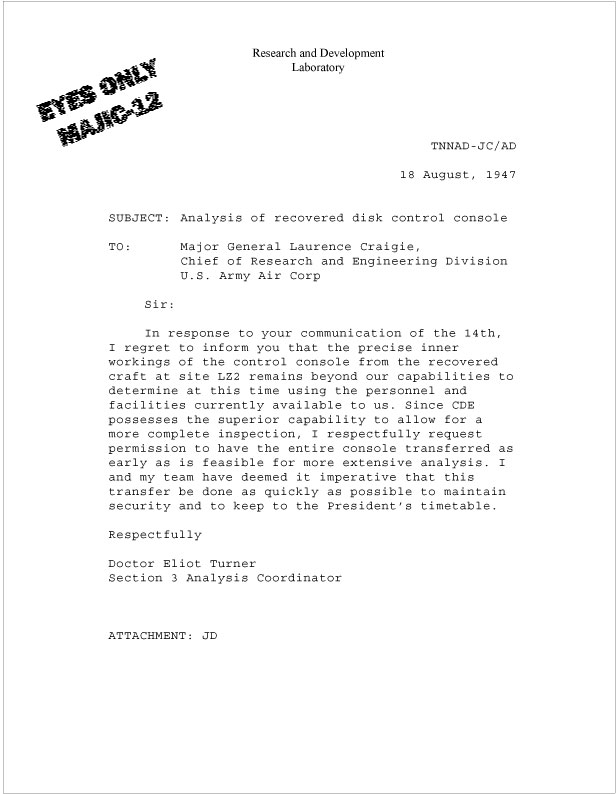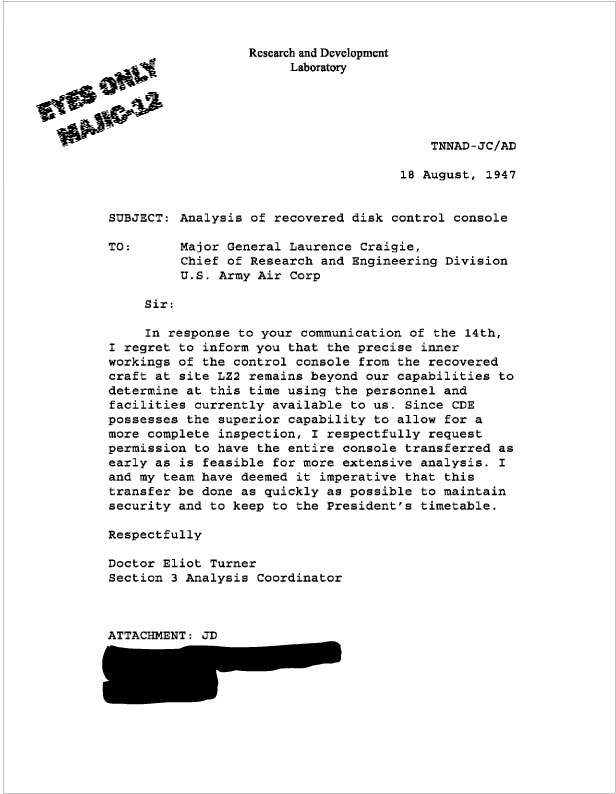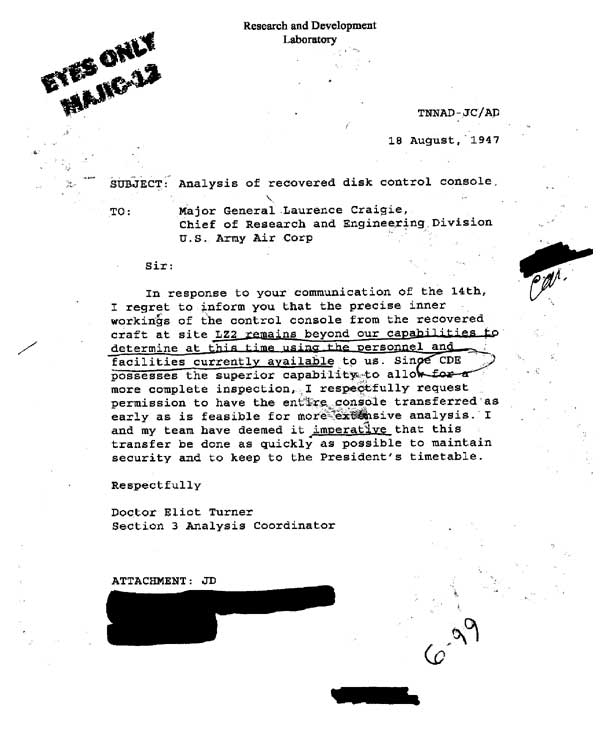
RETURN TO UFO PAGE | E-MAIL ME
HOW EASY IS IT TO FAKE A MAJESTIC DOCUMENT?
Since the Roswell
"crash" story was reintroduced in the late 70's, the tendency within
the UFO community has been to embrace the belief that the military has recovered
crashed disks and, in many cases, remains of their occupants, which they have
been hidden away in various secret facilities around the country for study.
Some have even gone so far as to insist that the government is in league with
extraterrestrials in keeping the public in the dark as to their activities and
intentions, breeding the atmosphere of suspicion and paranoia in which government
conspiracy theories thrive.
Perhaps nothing better illustrates this philosophy than do a number of allegedly
"top secret" letters known collectively as the Majestic 12 documents.
Supposedly a series of secret correspondence written between the White House
and a select group of senior military officers and scientists during the 1940s
and 1950s, in their entirety they are—if authentic—evidence that the
government not only was aware of extraterrestrials as far back as 1947, but
has been using the powers of the presidency to cover-up the fact ever since.
Even more, these letters imply that the military has recovered alien hardware
in its possession and is intent on suppressing the information through a "disinformation"
campaign designed to mislead the general public as to the true extent of the
government's involvement—a revelation which would obviously have profound
political and scientific repercussions if true.
Problems with the documents soon emerged, however, and many have been subsequently
exposed as hoaxes (though that remains hotly debated even among ufologists today)
but despite their frequent debunking, their impact on the UFO community remains.
In fact, it's fair to say that these documents have done more to create an atmosphere
of paranoia within ufology than any other aspect of the phenomenon, which has
only been detrimental to what serious study of the phenomenon has taken place.
In fact, a case could be made that were it not for the UFO communities' insistence
that the Majestic Documents be taken seriously, traditional science might be
more inclined to at least look at what evidence there is for extraterrestrial
visitation rather than to dismiss it out-of-hand as pseudoscience.
As someone who has worked with the ufology community, I am concerned about this
trend and appalled at the general lack of objectivity and logic among many of
its most rabid proponents. What I have always found especially irritating is
how easily many UFO buffs are to embrace any "official" looking document
as evidence without considering how easily it might be to create a false but
still very credible-looking document. So how difficult is it to create an authentic
looking top secret government document that might pass muster with the UFO crowd
using only a little imagination and some basic graphics software? I didn't know,
but as a graphic artist with thirty-five years experience in the industry, I
decided to take it upon myself to find out. What follows is the result of my
labors, performed over the course of a single evening with nothing more than
a basic computer and a propensity towards mischief.
Creating a Majestic Document
The first problem
one encounters, of course, is how to make a document look like something that
might have been generated by some government bureaucrat over seventy years ago.
I had to consider how it might be formatted, what terminology would likely be
used, who to send the letter to, etc. To do this, one might imagine it would
be necessary that I have a background in dealing with secret documents, but
such is not the case. All I need to do is study examples of the existing Majestic
documents (accessible at http://www.majesticdocuments.com) which, in already
having been "authenticated" by "experts", makes them perfect
templates from which to create my phony document. That, plus the fact that I
spent eight years in the military and so have some idea of how military jargon
sounds, should do the trick.
The next thing was determining a timeline. To keep it simple, I choose mid August
of 1947, which is about a month after the supposed Roswell crash and "recovery"
and the point when everyone was trying to decide what to do with the "debris."
Next, I needed to select my main characters. The MJ-12 document provides a cast
of potential figures to choose from, or I could simply make the document addressed
to no one in particular. However, if it's too generic, that also looks suspicious,
so I'll need to pick someone credible but not quite as high profile as Truman
or the other figures frequently mentioned in the Roswell story. I could have
used Army Air Corp General Nate Twining, who is frequently mentioned in regards
to the MJ-12 documents, but he's been done to death. I wanted someone a little
lower down the ladder but still high enough up the chain of command to be credible.
Plus, introducing a new name to the mix—especially one that has some historical
validity to it—would further enhance the document's credibility. After
doing a little research, I came up with the perfect nominee: Major General Laurence
C. Craigie, who was, at the time, chief of the Research and Engineering Division
at Wright Patterson AFB. Craigie, in being the man who would eventually authorize
the implementation of Operation Sign in December of 1947, was the ideal addressee:
he's important enough to be credible yet obscure enough to not be so high profile
as to receive undue scrutiny. His job at Wright Patterson at the time, along
with his later involvement in the entire UFO controversy, also makes him the
perfect candidate as well, and the fact that he's been dead since 1994 and so
can never be asked about any of this is a plus as well.
So who will be sending the report and what does he have to say to the general?
I'll have it sent from some obscure civilian research scientist, whom I've named
Doctor Eliot Turner. I know I'm taking a chance by naming this guy as the originator
of the letter, but since I don't identify which facility he's working at and
as the name Turner is reasonably common, I thought it would be difficult to
authenticate the existence of the man after all this time. That should be enough
to ensure the document isn't immediately debunked because of a lack of information
about the sender of the letter, as most researchers would probably give up looking
for the guy pretty quickly. (I call this the "needle in a haystack"
approach.)
So what does Doctor Turner have to say to the general? I must be careful here.
It has to be credible, somewhat routine in nature, and believable, yet be extraordinary
at the same time—a real "smoking gun" letter that, if true, would
blow apart the whole Roswell cover-up. It also needs to be short on specifics
and lacking in the sort of useful details the more hard-nosed investigator might
be interested in. Fortunately, since it also has to be brief, that should be
no problem. Let's see....I think I'll make it have something to do with the
instrumentation console on one of the crashed disks and how, due to the difficulty
of determining how the technology works, it needs to be sent to another facility
for further evaluation. Ten minutes later, this is what I came up with:
18 August, 1947
SUBJECT: Analysis of recovered disk control console
TO: Major General Laurence Craigie,
Chief of Research and Engineering Division
U.S. Air ForceSir:
In response to your communication of the 14th, I regret to inform you that the precise inner workings of the control console from the recovered craft at site LZ2 remains beyond our capabilities to determine at this time using the personnel and facilities currently available to us. Since CDE possesses the superior capability to allow for a more complete inspection, I respectfully request permission to have the entire console transferred as early as is feasible for more extensive analysis. I and my team have deemed it imperative that this transfer be done as quickly as possible to maintain security and to keep to the President's timetable.
Respectfully
Doctor Eliot Turner
Section 3 Analysis Coordinator
Notice that I refer to site LZ2 in my letter. This is something I picked up
from a Majestic Document called the Interpanetary Phenomenon Report—a seven
page report supposedly written by some group called the Interplanetary Phenomenon
Unit that discusses the recovery of fallen airborne objects in the New Mexico
in July of 1947. In it, they identify two potential crash sites which they refer
to as "LZ1" (the traditional Roswell crash site near Corona) and "LZ2",
a site 20 miles southwest of Socorro that, according to their report, "contained
the majority of structural detail of the craft's airframe, propulsion, and navigation
technology." Thus, by integrating details from a previously "authenticated"
Majestic Document and adding a few new details of my own, I've added an additional
(and much needed) layer of plausibility which should pass initial muster with
those already predisposed towards believing every Majestic Document to be legitimate.
Further, to provide an air of intrigue, I'm having the Doctor request permission
to send the console to someplace designated as "CDE" for further analysis,
the insinuation being that CDE is a coded designation for some unknown facility
(maybe Wright Patterson?) that possesses a more sophisticated research capability.
Using three-letter designations is a method the military frequently uses to
maintain a degree of security when discussing travel plans or specific military
installations; obviously, unless one knows where CDE was, they wouldn't know
where the console was being sent.
Oh, oh, I've made a mistake. I put U.S. Air Force in the header, forgetting
that the USAF wasn't estabablished until September of 1947, a month after the
letter was written. Better change it to U. S. Army Air Corps so I can remain
historically accurate.
There, I fixed it. Okay, so I've got a decent start. I've checked my facts and
made sure the story holds together historically, at least on a superficial level.
Now I have to set it up so that it looks like I typed it on a clunky old manual
typewriter back in 1947. Of course, I could just go out and try to purchase
a typewriter from that era (which is what I would do if I were really serious
about perpetrating a hoax) but for the sake of time and since this is only a
demonstration and not a genuine effort to fool anyone, I'll make do by using
the courier font on my computer. Laying the entire thing out in Illustrator,
fifteen minutes late my "document" looks like this:

Not bad, but the problem is that my version is too clean looking, especially when compared to the barely legible documents in the Majestic collection (many of which are almost unreadable). As such, I needed to "dirty" it up a bit to make it appear as though it's a copy of a copy of a copy that's gone through the proverbial wringer a few times. Fortunately, this is easy to do; I simply converted the text into vectored objects and rasterized it (turning it from vectored text to pixels). To get a more blurry effect, I next converted the entire image into a bitmap, and added a black censor's block on the bottom designed to make it look as though someone is concealing information (wouldn't you love to know what's under there?), giving it the following appearance:

Better, but still too neat. I need to take this further if I want to really make the page look old and weather-beaten, which I achieve by adding some handwritten notes, crude underlining, spill coffee on it—whatever.... Then, as a final step, I scan the document, further degrading it in an effort to achieve the desired effect. This is what emerges from my frenzied efforts:

Viola!
Notice how much it looks like a Majestic document. It's not perfect, but not
bad for an hour's work.
Of course, this little impromptu demonstration doesn't prove that the Majestic
documents are fake, but it does show just how easy it is to come up with a reasonable
facsimile of a purported top secret document using only one's imagination and
some common software. Imagine what mischief I might be capable of were I to
put some real time and effort into creating a fraudulent document and foisting
it upon an unsuspecting public (as I suspect a few folks have done in the past)?
Scary to think about, isn't it?
The point of all this is that if the prospect that Earth has been or is being
visited by extra-terrestrials is ever going to be taken seriously, ufologists
have to become far more discerning. Only in that way will the legitimate evidence
ever see the light of day.
CAVEAT EMPTOR